Related Content
Content
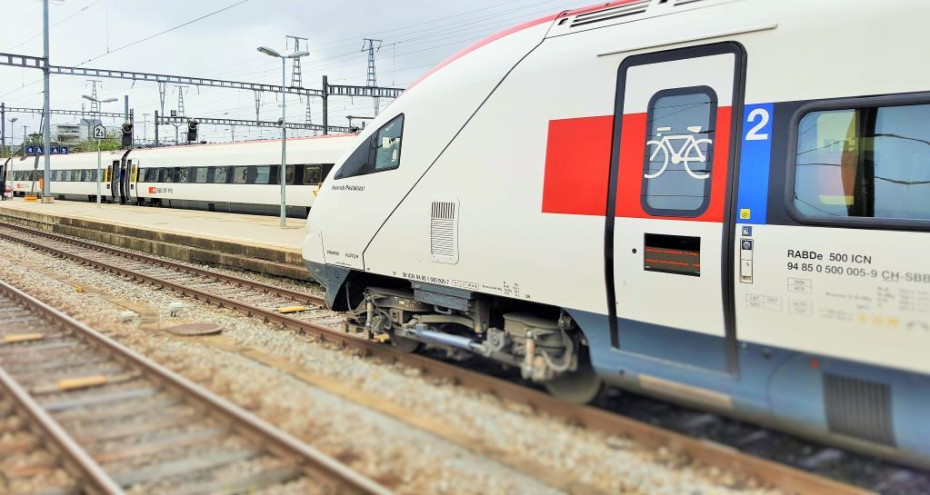
Taking A Bike on European Trains
Travel with bicycles on trains in 13 European countries and on the international rail journeys between them.
Share
Many stations in Europe inevitably happen to be in beautiful areas that entice exploration, so taking a train into a landscape and then pedaling off by bicycle to see what awaits you can often be fabulous.
And there are also those train journeys when for practical reasons you need to take your bicycle with you, after all you need to get to those wonderful locations in the first instance.
Like so many other aspects of European train travel, there are no universal rules around how to travel with a bicycle on a train.
The policies around transporting bicycles are set by each train operator and then they are ALSO dependent on the trains that are used on each route.
Though all European train operators have separate rules for non-folding and folding bikes.
Travelling with folding bicycles:
If you place folding bikes in their travel bags, then usual luggage rules are applied.
Meaning that you can travel with them on the train as you would with other bags, but you’ll need to place them on the floor and not in luggage racks.
Unless SMTJ has specifically stated otherwise in the country guides below, then this, to the best of our knowledge, is the policy for travelling with a folding bicycle in that particular country.
Common rules for taking non-folding bicycles:
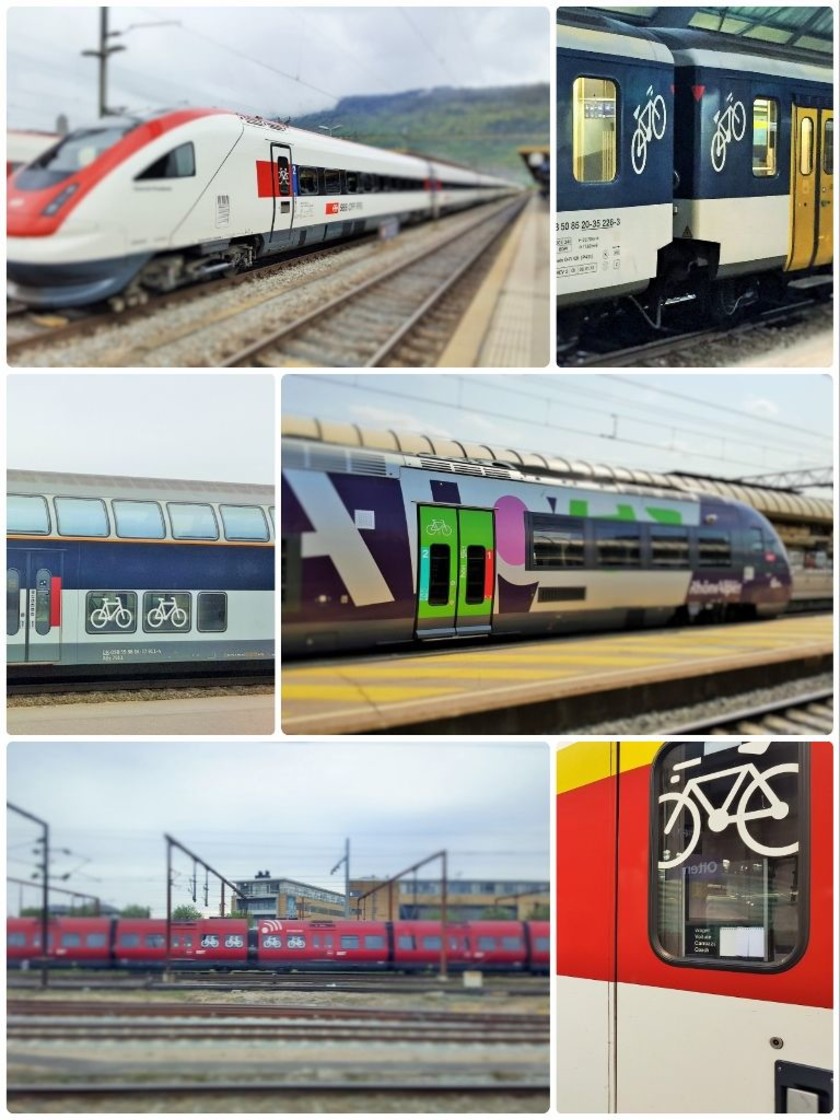
If you want take a non-folding, ordinary bike (not an e-bike or tandem) on to a European train, the terms can vary between countries, hence the specific country guides.
Though these six ‘rules’ TEND to be commonly applied, regardless of the country in which you want to take a bike on a train.
1: If a train is equipped with a dedicated bike storage space, then it will usually be the only place on the train in which you can leave your bike.
2: But if you CAN’T reserve a space on your bike in these dedicated storage areas, which is more common than being able to make a reservation, there will be no guarantee that places will be available.
If they’re not, the conductor is usually supposed to either prevent you from boarding, or request that you leave the train at the next station.
Whether a train conductor, who may not speak your language, will bother to impose the T&Cs of travelling with a bike upon you, or give up and move on, is something that you can’t rely upon.
3: It’s more likely than not, that you will need to buy a ticket for your bike.
However, despite having a ticket, if bike reservations aren’t also available, there’s no guarantee that you’ll be able to travel by your first choice of departure,
This particularly applies if you will be joining a train at an intermediate station.
4: When they are available, bike reservations can be distinct to a bike ticket, more often than not, they have to be purchased separately, so will cost extra.
5: When they are an option, bike reservations for journeys WITHIN a country can be booked online - but the reservations on international journeys usually have to be booked at stations.
Although it's now worth checking to see if you can book a bike reservations by using the direct messaging on a train operator's social media channels.
6: If you can disassemble a bike, so that it will fit within the dimensions allowed for folding bikes, you’ll USUALLY be able to take a non-folding bike as hand luggage – the national rail operators in Italy (Trenitalia) and Spain (Renfe), make specific reference to this being the only means of taking a non-folding bike on board their express trains.
If you don’t disassemble a non-folding bike, you definitely won’t be able to take it on board these national express train services:
Altaria (Spain); Alvia (Spain); Avant (Spain); AVE (Spain); Euromed (Spain); Frecce trains (Italy); ICE 1 (Germany); ICE 2 (Germany); ICE 3 (Germany); ICE T (Germany); Intercity (Italy only); Snabbtag (Sweden); Talgo (Spain) and TGV Duplex (France).
General pre-travel advice:
If you want to take a bike on to a European train, we recommend carrying out these simple steps:
(1) Look up your journey online, even if you’re not ready to commit to buying a ticket.
The majority of ticket booking websites now indicate whether you’ll be able to take a bike on board a specific departure – though you may have to seek out this info by clicking on ancillary links such as luggage or additional passenger info.
(2) If you know that reserving bike spaces is either mandatory or an option, (as mentioned in the country specific guides ), it’s best to reserve online as soon as possible – as places will be limited.
You may as well add a bike reservation* when booking your train tickets online - on most routes on which bike reservations are available, you will also save money by purchasing train tickets in advance.
*You might need to also book a separate bike ticket.
(3) Never assume that you can just automatically take your bicycle on to a train. If you don’t look up your journey, or the info isn’t clear, try to visit a staffed station when you first arrive somewhere, to confirm what you’ll need to do when you do want to travel with a bike.
(4) Even if you have purchased your tickets in advance, try not to turn up at a busy station less than 15 minutes before your train is due to leave.
Allow time to try and ask the station staff what you’ll need to do and to check where you’ll need to wait with your bike.
Give yourself at least another 30 minutes if you will be buying tickets at a main station, to allow for contingencies such as not understanding a ticket machine, long ticket counter queues and taking care of any pre-boarding procedures such as filling in luggage forms.
The departure indicators on a platform/track which can feature train formation info, such as the locations of the 1st class seats, or the restaurant cars, will rarely indicate where you should wait for easy access to the bike spaces.
Usually only one coach/car/carriage on a train will house the bike rack and the signs on the outside of the train, can be hard to spot when a train pulls into a station.
Taking a bike is possible
Don’t be put off from taking a non-folding bicycle on a train, knowing what you need to do before boarding will help make it straight-forward, hence the info below.
The opportunities to travel with a bike are increasing, as racks for bicycles are becoming near standard features on the new trains that are being introduced across Europe.
Austria:
On local and regional trains:
OBB is the national rail operator in Austria and it classifies its local and regional train services in rural (scenic areas) as REX and the equivalent in the cities are the ‘Citybahn’ and S-Bahn services.
You need to purchase bike tickets prior to boarding any of these local and regional train services, and these cost the equivalent of 10% of the adult 2nd class ticket price.
Though you can only take bikes on trains that have designated storage area, but as the OBB website points out, spaces in these locations on the REX and Citybahn trains can’t be reserved.
Therefore you can’t guarantee that places will be available; and some routes served by REX trains only have departures every other hour, particularly at weekends.
If you discover that no spaces on the racks are available, don’t assume that you’ll need to leave the train, instead seek out the conductor on the train and check what your options are.
Also be aware that not all of the trains used for REX services are equipped with bike racks.
On some routes, particularly the lesser-used rural branch lines, all or most of the trains won’t have them – meaning that bikes aren’t permitted on these trains.
However, OBB has a useful journey planning facility which enables potential travellers to assess how to get from A to B with a non-folding bicycle.
So it’s worth checking to see if you can book a ticket for yourself and your bike on the OBB website, if you see ‘tickets are not available’, you’ll know that you can’t take bikes on that particular journey.
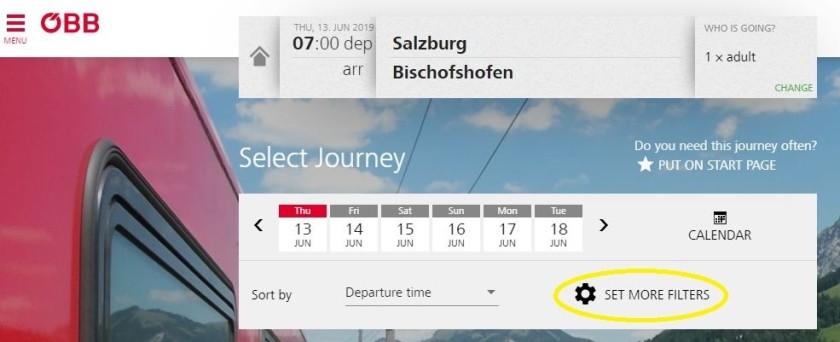
When looking up a journey the trick is to search as though you won't be taking a bike, but then when presented with the journey options click the option to 'Set More Filters'.
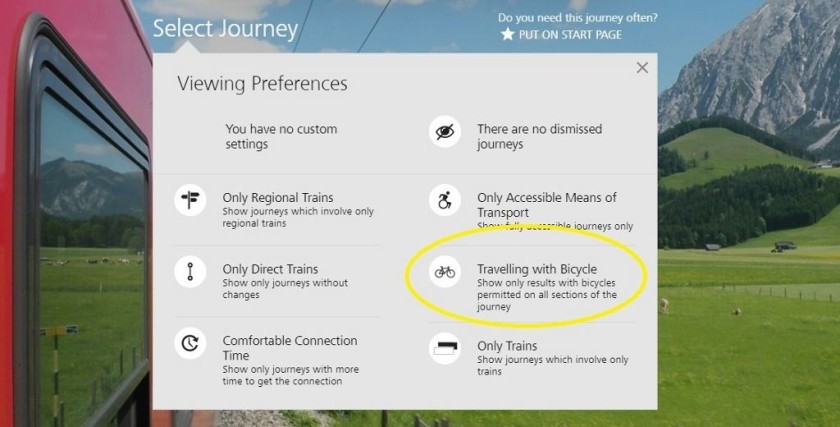
Then having done that, click the option ShowMeTheJourney has highlighted above.
So it’s worth checking to see if you can book a ticket for yourself and your bike on the OBB website, if you see ‘tickets are not available’, you’ll know that you can’t take bikes on that particular journey.
Travelling with bikes on an Austrian express trains:
If you want to take a non-folding bicycle on an express train service in Austria; the EC (non-international journeys) and IC and Railjet services, then a space for your bike(s) has to be reserved on these trains prior to boarding.
The reservation fee per bike is €3, BUT this reservation fee will be in addition to the journey price for the bike(s).
Spaces are inevitably limited so booking ahead is recommended; it makes sense to add a bike(s) when booking journeys online, as by booking in advance you will be able to obtain discounted 'Sparscheine' tickets for the train journey.
Though the journey element of the price for conveying a bike will solely depend on distance travelled, so this isn't discounted.
Though be aware that bike space reservations on the Railjet trains in particular can sell out days in advance.
On the Innsbruck to Feldkirch via St Anton route the Railjet and EC trains are the only services available west of Landeck-Zams, so if the bike space reservations are sold out, no alternative trains will be available.
General information for booking train tickets for Austrian journeys online is available here.
on the ICE trains to Germany
Bikes cannot be taken on board the ICE T trains that travel between Vienna and Wels via Linz.
How to book the tickets
The steps you need to take on the OBB website to book a bike on to an express have recently been made a lot simpler, you simply add the need to take a bike into the booking path.
Step One:
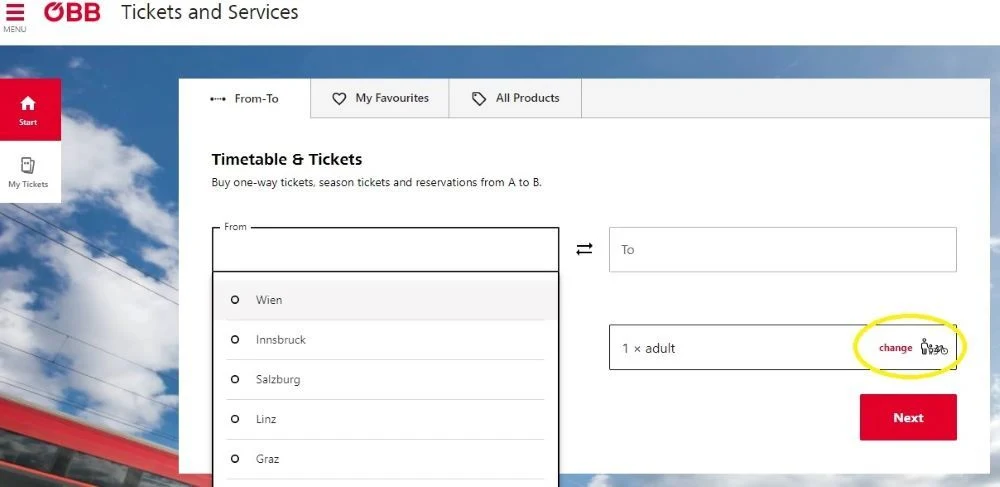
As you begin to look up a journey, the option to add a bike ticket is clearly marked.
Step Two:
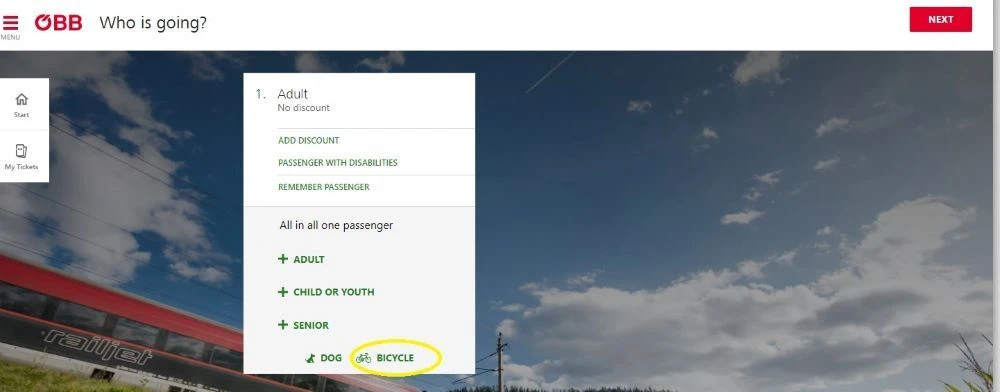
Having clicked on the bike symbol, click 'Next' at top right.
Step Three:
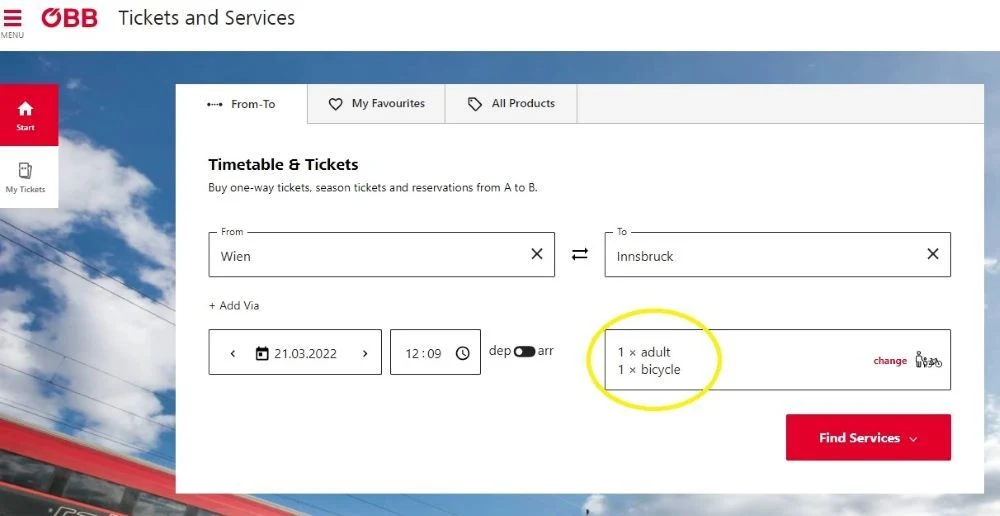
With the bike added to the travelling party, the information you will then see on the booking path will include the departures with spaces available; and the price total(s) will include the bike ticket / reservation.
Belgium:
All trains within Belgium are operated by SNCB and it charges a flat fee of €4 per journey per bike, you can buy these tickets at the station from ticket counters or machines.
Your passenger and bike tickets won’t be specific to a particular departure, because SNCB doesn’t offer reservations on its trains.
What is vague is that the conductor on the train will apparently show you where to place your bike on the train – not all of SNCB's trains have designated bike spaces.
The travelling with bikes page on the SNCB website has limited info, but the suggestion that you should travel outside peak times, implies that there is a possibility that the conductor will prevent bikes from being allowed on to exceptionally busy trains.
Also some trains will be lengthy with more than six coaches/carriages/cars, so the conductor may be hard to find.
So check with the booking clerk, or at the information desk, what you’ll need to do and where to wait, before making your way to the platform/track that your train will be leaving from.
Czechia:
A facility for conveying non-folding bikes is available on the majority of trains provided by the national rail operator CD and for journeys within Czechia/The Czech Republic on the international train services.
But the specifics of how you travel with a bike, both in terms of ticketing and how your bike is handled on board, is very much dependent on the route you will be taking and the type of train providing the service.
What can be a big help in working out how to travel with a bike is checking the information per departure that can be discovered on the CD website - the key step when looking up a journey online is to click on the 'Details' button - circled in yellow.
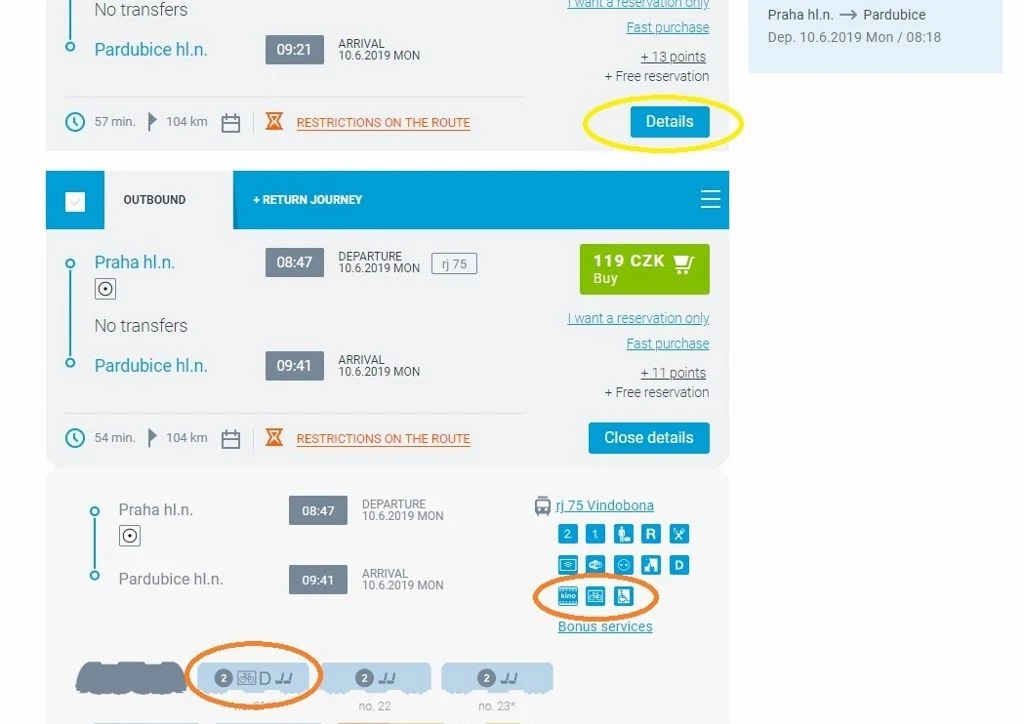
It will allow access to a series of blue squared symbols which will show the services available on a specific departure, including whether dedicated bike storage space is provided:
- a bike within a square (as in the example shown, circled in orange) indicates that bike spaces have to be reserved,
- a bike in a circle indicates that reserving space for a bike is available, but optional,
- while just a bike indicates that they can be taken on board, but the train has no dedicated bike storage.
Also note the coach/car in which the bike storage will be located is also indicated, so in this instance the facility will be available in the first coach behind the locomotive.
Even if you don’t want to book tickets online, it’s worth knowing what the ‘rules’ are, as on some routes they can vary between departures.
Though one of these rules is that a space for your bike must be reserved prior to boarding if you travel by any of the express train services - EC, Ex, IC, RJ or SC.
On boarding you hand your bike to the conductor and they will stow it for you; on the CD website you can look up in which coaches/cars on the train, the bike storage facility will be located.
On the Regional trains
If you will be travelling on a Regional train service, the rules can vary depending on what route you will be travelling.
Hence it being a good idea to look up a journey by Regional trains on the CD website, as the four main variations are:
(1) Bike spaces must be reserved prior to boarding.
(2) Bikes aren’t permitted at all.
(3) There won’t be dedicated storage facility, but if there’s room available by the front or rear doors, you’ll be able to take a bike on board.
This is most typical on local trains outside of Praha/Prag - though whether there will be room to stow a bike will be at the discretion of the conductor.
(4) Bike storage that can be reserved is available, but optional - so if you don’t want to use it, you will still be able to take a bike on board, if the conductor deems that space is available elsewhere on the train.
A plus of using the storage is that you won’t have to supervise or manage your bike during the journey.
But checking online whether this particular facility will be available on the departure you want to take, can require a few leaps of logic.
On this example there is no bike symbol on the train info section.

But clicking on the 'Train detail' button reveals this information.
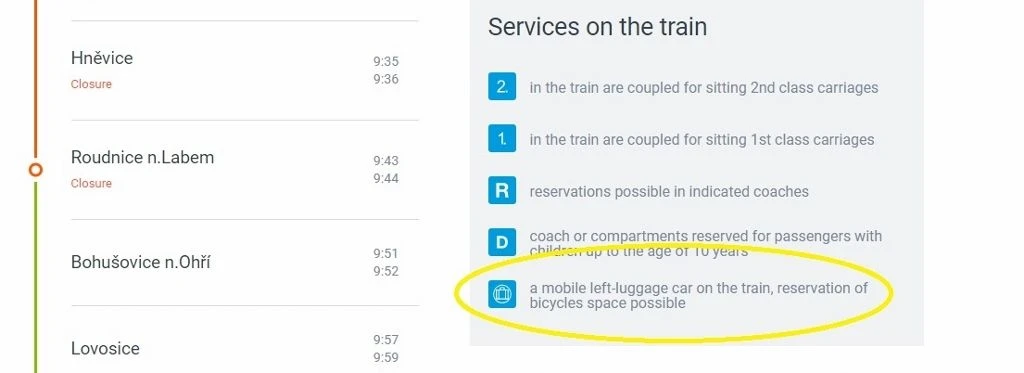
which shows that spaces for bikes can be reserved in the luggage area.
Booking Bike Tickets:
These three things are particularly worth knowing if you want to take a bike on a train in Czechia/The Czech Republic
(1) You must purchase a bike ticket for any journey and these are distinct from your personal travel ticket(s) - day passes for journeys by multiple trains are also available.
However, as the price of bike tickets is solely dependent on the distance you will be travelling and not how far you book in advance, you won’t lose out financially by waiting to book these bike tickets at the station.
(2) If you won’t be taking an express train, check whether there is an OPTION to hand your bike to the train conductor for supervised bike storage; there is an ADDITIONAL charge for this service, but it is only CSK 20 (just over €1).
The booking clerk may assume you’ll want to make use of it and automatically add it to the price.
(3) If you will be taking an express - EC, Ex, IC, RJ or SC train service, you will need to reserve a space for your bike, but reservations for bikes AND bike tickets are two separate entities.
When booking tickets online for these trains there will be an option to add ‘a bike’ to your booking, but what won’t be clear is that you will be purchasing or requesting the bike reservation and NOT the bike ticket(s).
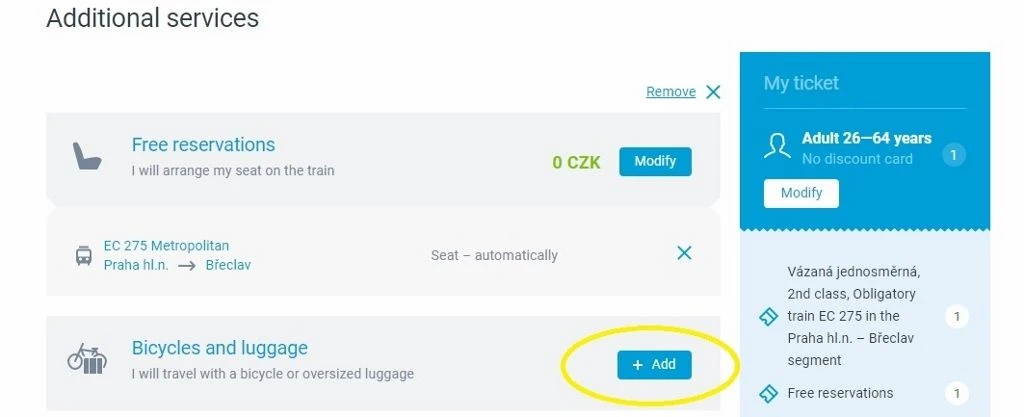
Having clicked on the 'Add' button you will see...
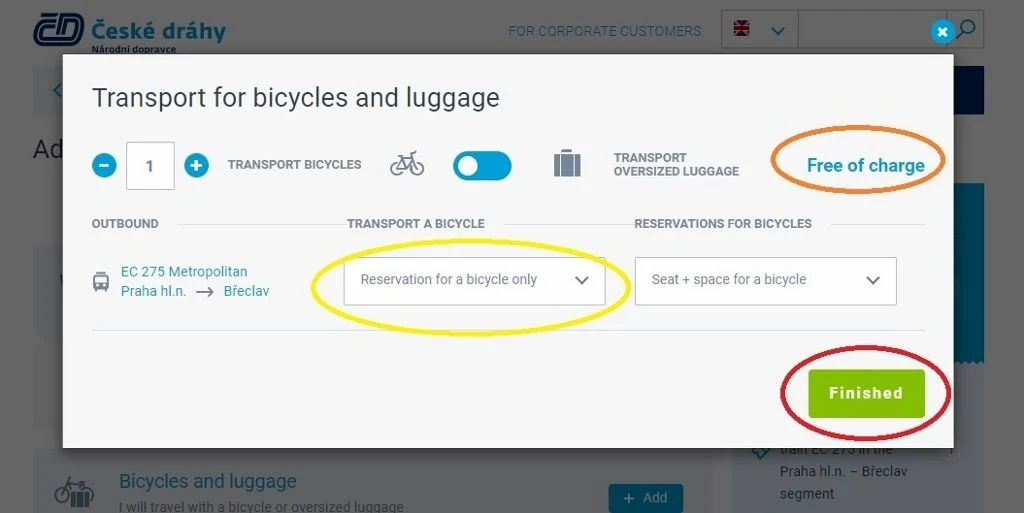
...note that the bike reservation is free of charge if you add the bike reservation when booking a journey ticket which equates to a saving of CZK 35-50, as that's the price you will be charged if you subsequently book a bike reservation online, or at the station.
Booking Czech rail tickets
More info about booking train journey tickets in Czechia/The Czech Republic is available HERE.
However if you reserve a space for your bike when looking up a journey on the CD website, you will still need to also have a ticket for your bike; and the bike tickets have to be booked separately.
So when bike reservations are compulsory, the three options are:
(1) Add the (free) bike reservation to your online ticket purchase, and then purchase a bike ticket at the station prior to boarding (the bike tickets won’t sell out).
(2) Book the train ticket and bike reservations online and then purchase a separate bike ticket online; to purchase the bike ticket, it’s best to click the green button on this travel with bikes page.
(3) At the ticket counter, purchase a train ticket, a bike ticket AND a reservation for the bike.
Denmark:
The national rail operator in Denmark is DSB and you can take folding bikes on any of its trains as hand-luggage, as long as when folded the bike measures no more than115x60x30 cm and you leave it on the floor of the train.
For non-folding bikes the ‘rules’ differ according to the type of train service you will be taking.
For journeys by the IC (InterCity) and Lyn express train services you need to purchase a ticket for your bike prior to boarding and these cost a flat rate of DKK 30 (approximately €4).
You cannot book these tickets online, so you’ll need to use a ticket counter or machine, but the bike ticket doesn’t guarantee that space will be available on the train – also bikes cannot be taken on board at all on some (the busiest) departures.
Reserving bike spaces on the express trains
Though it’s possible to reserve a bike space on a specific IC or Lyn departure on which bikes will be accepted.
You can do this when booking at a DSB service desk in stations that have them (only the main city centre stations), or by calling DSB (Danish national railways) customer services +45 70 13 14 15 - the only means of making a reservation in advance from outside Denmark.
The customer service agent will give you a reference number that you can enter into a ticket machine.
Booking a bike space on an IC or Lyn service is mandatory between May 1st and August 31st, but for peace of mind, ShowMeTheJourney’s recommendation is to book a bike space on these trains regardless of your travel dates, particularly as you will only pay the standard bike ticket price
You’ll then be committed to travelling by a specific departure, but if you book an ‘Orange’ discounted ticket, you’ll have to travel by the train you selected in any case.
You may as well book the train ticket and the bike reservation on the phone in the same transaction - and then you’ll also be able to confirm what your options are, in terms of choice of departures etc.
You can book from two months ahead of your travel date.
Taking the regional and local trains
If you be will be travelling by Regional or local trains* outside of Copenhagen, you need to buy a ticket for you bike, but the price depends on the distance you will be travelling – they tend to be around 25% of the price of an adult ticket.
Tickets can be purchased from a ticket machine, or a ticket counter, although only the largest main stations have ticket counters, but if you want to buy a ticket from a person, what’s good to know is that tickets are also available from 7 – 11 stores.
*The local trains in North Zealand, which are operated by Lokalbaner and connect with DSB’s trains in Hillerod and Helsingor are an exception, you don’t need to purchase bike tickets to take a bike on these trains.
The Oresundstag trains between Denmark and Sweden require specific bike tickets, which are sold at the equivalent price of a child ticket per journey.
According to the DSB website, they can only be purchased from DSB ticket machines, ticket desks or 7-11 stores.
You don’t need to purchase bike tickets for the S-Tog trains, the local/commuter trains in Copenhagen, but you cannot take a bike through Norreoport station, in the heart of the city, between 07:00 – 09:00 and 15:30 – 17:30.
On the IC /EC trains between Denmark and Germany
Bike spaces must be reserved prior to boarding, so it's best to book tickets on the DB (German national railways) website, even when travelling from Denmark.
Click the 'further options' on the search box and then tick 'travelling with bicycles'.
The ticket options you'll then see when looking up a journey, will then include the bike reservation.
France:
The usual travel ‘rules’ in France for folding bikes, bagged and placed on the floor by your seat, can also apply to standard bikes - IF you can fit your bike in a bag measuring 120cm X 90cm max, by removing its front wheel and then by placing it and the rest of the bike in the bag.
If you CAN'T meet those requirements, the rules for taking a non-folding bike on a train vary according to both the type of travelling you will by AND in which region you will be travelling; though it is now much more likely that you will be able to travel on French trains if you don't disassemble your bicycle, compared to the services on which this isn't possible
What is particularly useful is that the recently launched national train ticket / travel ticket service, SNCF Connect, has incorporated the ability to 'add a wish' to travel with a non-folding bicycle into its journey search service.
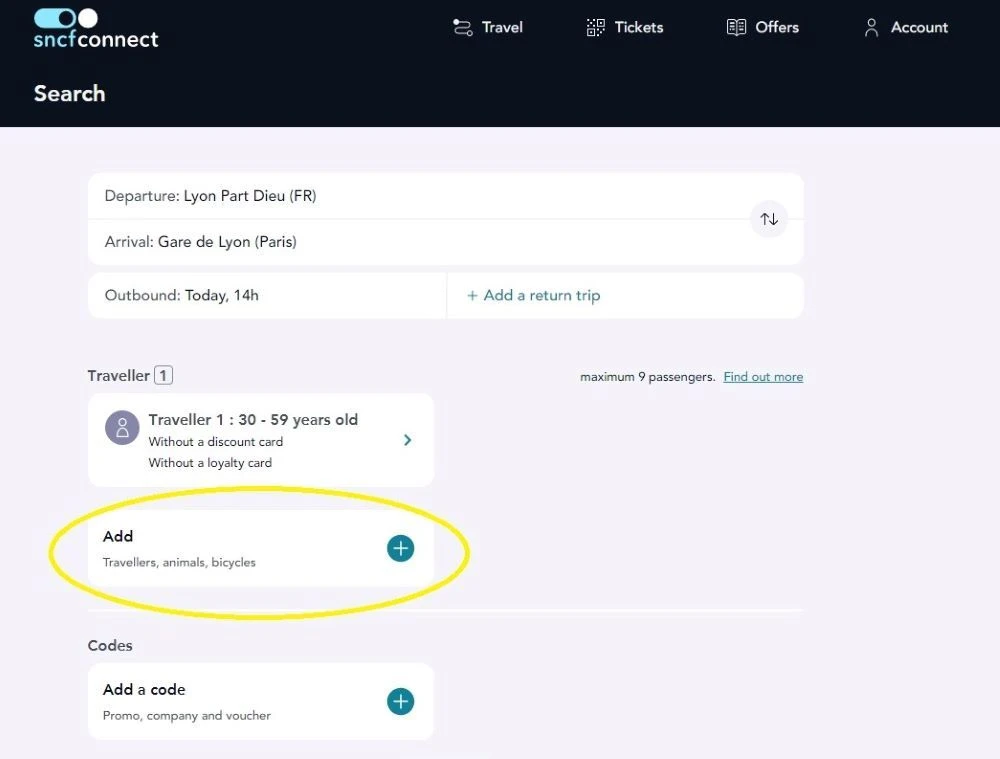
So without buying a ticket, you can look up a journey and check which departures you can take a non-folding bike on board.
The ticket prices you will see for journeys by TGV and Intercités trains will include both your travel AND the bikes; general info about booking French train tickets is available here.
Taking bikes on express trains in France:
You can take a non-folding bicycle on board Intercités trains for a flat fee of €5 regardless of the distance you will be travelling; and this price has recently been reduced by 50%.
For journeys by TGV, a recent change is that a flat-rate reservation fee of €10 now covers journeys by any TGV InOui service, including the previously excluded double-deck TGV Duplex trains.
If you will be travelling by an Intercités, TGV Atlantique, TGV Duplex or TGV POS train, you usually have to interact with the train conductor, so when you’re at the station it’s worth checking what you’ll need to do.
Particularly if you won’t be joining a train at its starting point, so will have limited time on the voie (platform/track) to work out what the procedure is, when the train arrives.
However, the new TGV Oceane trains have been fitted with bike racks, so when you book a bike ticket on these trains, you will be reserving a space on the rack.
What’s also worth knowing is that you can’t book Premiére/1st class tickets for journeys by TGV or Intercités if you want to travel with a bike; presumably because the bike storage on these trains isn’t adjacent to the Premiére Class seating areas.
Taking bikes on Ouigo train services:
For travel on the Ouigo train services, bike tickets cost €5, but they are subject to meeting the terms and conditions - and the key thing to be aware of is that pre-boarding, you have to prepare a non-folding bike for travel
In particular, the bike;
- must be disassembled and covered
- the cover must not exceed 130 x 90 cm
- the maximum weight is 30kg.
Taking a bike on regional trains in France:
In France the regional trains are the TER trains and most local train services outside of the Paris area are also classified as TER services.
You won’t need to purchase bike tickets for journeys by TER trains, but each region in France co-manages its TER trains with the national rail operator SNCF and the region can set certain stipulations, such as bikes not being allowed on trains at all at busy times.
Though what is universal is that when dedicated bike spaces are provided, they will be the only places on the train in which bikes can be stored and they're allocated on a first come - first served basis.
Meaning that you can't absolutely guarantee that space will be available for your bike(s) - and many TER routes, particularly in rural areas, have gaps of two hours or more between departures.
Though what's relatively new is that some TER routes and services now offer 'jumbo' bike storage facilities
These include:
Vélodyssée trains, which can accommodate 17 - 25 bicycles, on routes which link Bordeaux to Arachon, Hendaye and La Rochelle.
The Train Velo Loire service, which can accommodate up to 83 bikes) on the Le Croisic - Nantes - Tours - Orleans route.
More detailed info for each region is available by using the bike menu on the TER interactive map.
You can also take a bike on board a Transillien train, the longer-distance commuter routes to/from Paris EXCEPT when travelling on Monday to Friday between 6:30 - 9:30 and 16:30 - 19:30.
Germany:
How you travel with a non-folding bike in Germany depends on the type of train service you will be traveling by.
On the IC and EC trains
Taking a non-folding bike on board an IC train, or an EC train for a journey within Germany:
All of the express trains used for these services have bike racks, so to take a bike on board you need to both purchase a ticket AND a bike reservation, in order to secure a space for your bike.
The flat rate fee, irrespective of distance, for a combined bike ticket and reservation is €9.
Travelling with a non-folding bike on an ICE train
Only the relatively new ICE4 trains and the latest variant of the ICE 3 trains are fitted with bike racks.
Limited space for non-folding bicycles is also now available on ICE-T trains.
So it’s not possible to travel with a non-folding bike when ICE 1, ICE 2, and the older types of ICE 3 or **are used on a departure.
That €9 ticket and reservation fee also applies for journeys by ICE4 trains.
IC trains are nearly always available as alternatives to those ICE trains on which bikes aren’t permitted.
On local and regional trains
Non-folding bikes can generally be taken on board Regio and S-Bahn trains, but specific terms and conditions such as, bikes being restricted at certain times of day (rush hours) and whether bike tickets are required, are dependent on the region in which you will be travelling.
The specific terms can also include only needing to purchase a bike ticket during rush hours, or bike tickets being valid for a day’s travel and not just on specific departures.
So it’s worth clicking on the links to the specific regional information on this page on the DB website– using Google Translate if need be.
Though what’s universal when taking bike on to any Regio train service is that bike spaces can’t be reserved in advance, so you cannot ever be 100% certain that space will be available on the train that you have boarded.
If it’s not, then it’s likely that the conductor will ask you to leave the train.
Making use of the DB website
Though what can hugely help with making sense of all the above - and for planning journeys which avoid the ICE trains that don't permit non-folding bikes on board, is to make use of the additional journey search options on the DB website.
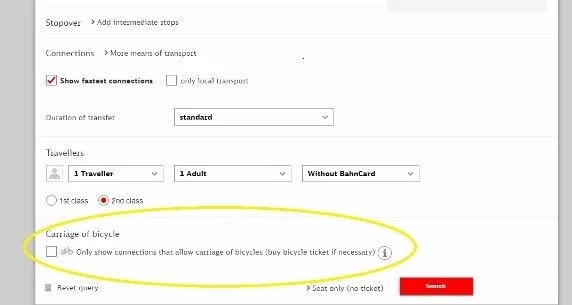
You need to click on the circled button on the home page BEFORE you look up a journey.
Then having doing so, towards the bottom of the screen, you will then see.

Italy:
On all the express trains, the Frecce and InterCity services, you can only take a non-folding bike on board if you disassemble it and fit it in a bag with maximum dimensions of 80 x 110 x 40cm.
If you can fit it in the bag, you can take your bike on board any Trenitalia service free of charge, including the R/RV trains - this is Trenitalia's information re: taking bikes on its trains.
But if you don’t want to take your non-folding bike apart, the only Trenitalia train services which will accept it are the Regionale (R) and Regionale Veloce (RV) services that have dedicated bike storage spaces available on board on the train.
This also the ‘rule’ on the Regionale services in northern Italy which are operated by Trenord, you have to place your bike in the dedicated areas.
However many different types of train are used on these R and RV services, so there’s no absolute guarantee that the facility will be available - though the majority of these trains do offer bike storage.
Looking up a journey on the Trenitalia website
Hence it’s definitely worth checking whether bike storage will be an option on a specific departure, by looking up the journey you want to take on the Trenitalia website – it also includes the services operated by Trenord.
On the journey search results click on the easy to miss 'i' icons.
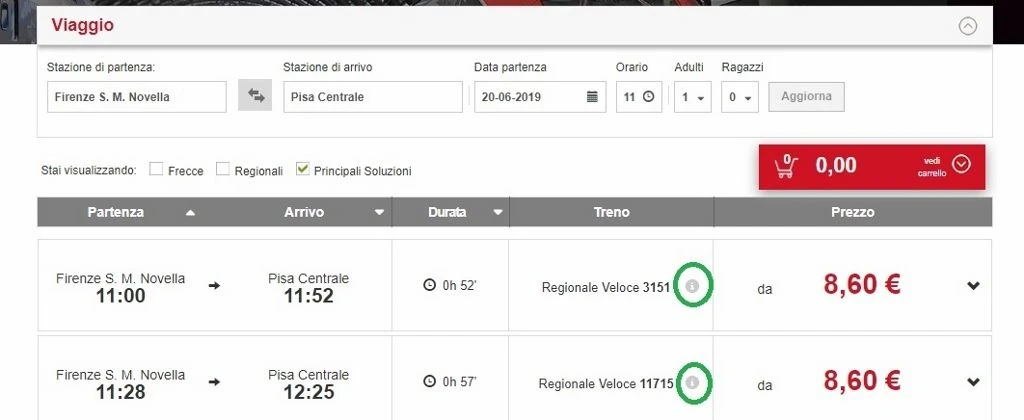
Then having clicked on these buttons, you will see the equivalent of

However, there’s little point in booking a ticket for these R/RV trains online, you won’t save any money; and the Trenitalia website doesn’t sell the tickets required to take a non-folding bike on the train.
So it's best to buy the train journey and bike tickets, that cost a flat rate of €3.50, at the station - or at a nearby 'Tabacchi' store if the station doesn't have a staffed ticket office or working ticket machines.
The bike tickets will be valid for 24 hrs and along with your train journey tickets, they also need to be validated in the ticket stamping machines.
If bike storage is available, it’s location will be indicated by symbols on the outside of the train, if you don’t see it, an option is to board in any case and then be proactive and seek out the train conductor to check what you need to do.
Also seek out the conductor as soon as you are on the train, if you weren't able to buy tickets before boarding.
If you are proactive and explain that you weren't able to buy a ticket, you will pay the standard fares for you and your bike, but if you wait for the conductor to come to you there will be an additional €5 fee.
Some trains have storage room for no more than five bikes, so if you board and no space is available, you may have to take the next train, despite being in possession of a train and bike ticket – bike spaces can’t be reserved.
Norway:
On the long distance rains spaces in the bike storage can be reserved in advance, there is a travelling with a bike option within the journey search service on Vy, the national rail operator's, website.
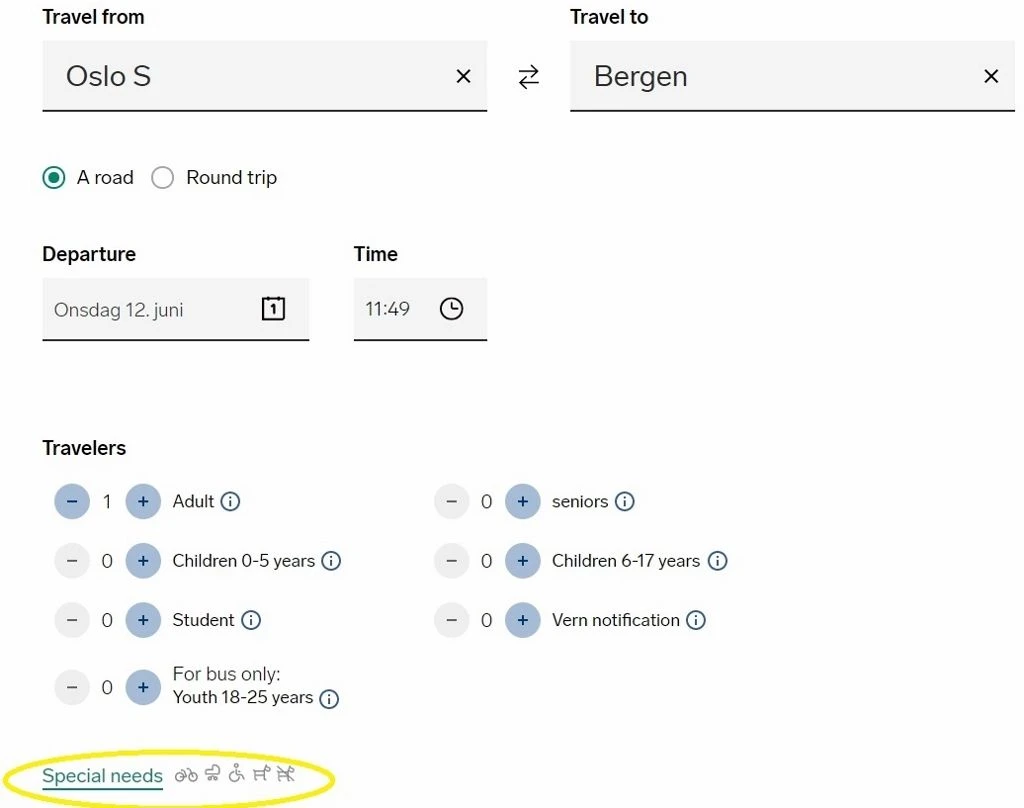
The reservations of the bike spaces will be included with the bike ticket, but they're comparatively expensive.
There are now three core rail operators in Norway
1: Vy - includes trains on the Oslo to Bergen route and the trains between Oslo and Goteborg in Sweden, plus the regional trains from and to Oslo.
On most of its routes the core terms for travelling with a non-folding bicycle on Vy trains is that tickets are required which cost 50% of the Non-Flexible ticket price, but with a maximum price of NOK 235.
Spaces have to be reserved when travelling between any station on the Bergen Line, between Oslo and Bergen (a maximum of 15 spaces are for bikes are available on these trains) and for journeys on the Gjøvik Line (a maximum of 17 spaces are available on these trains)
Spaces will be assigned when booking tickets to travel by these trains online (see below), though in summer a fixed rate is applied to journeys between stations on the Bergen Line, regardless of distance.
Despite bike tickets being required pre-boarding, spaces for bikes cannot be reserved on Vy's other routes, but the number of bike spaces per train is limited.
The number of spaces per trains on the key routes is typically:
Oslo - Lillehammer = 20
Oslo - Halden and most local services = 5.
2: SJ NORD - includes trains between Trondheim and both Oslo and Bodo
On most of its routes the core terms for travelling with a non-folding bicycle on SJ NORD trains is that tickets are required which cost 50% of the Non-Flexible ticket price, but with a minimum price of NOK 43 and a maximum price of NOK 215.
The bicycle must be able to be hung on the hooks in the cargo area. It can be a maximum of 175 cm long and have a tire diameter of a maximum of 5 cm.
On the longer-distance services, spaces are reserved when adding a bicycle to a ticket booking (seat below) as bike tickets for these trains have to be booked online.
For electric bikes, the lithium-ion batteries must be removed and taken in the hand luggage, and the battery must not be charged on board.
3: Go Ahead Norge - includes the trains between Oslo and Stavanger
On the longer-distance services, spaces are reserved when adding a bicycle to a ticket booking (seat below) but on other routes spaces for bikes are not guaranteed.
The bicycle must be able to be hung on the hooks in the cargo area. It can be a maximum of 175 cm long and have a tire diameter of a maximum of 5 cm.
For electric bikes, the lithium-ion batteries must be removed and taken in the hand luggage, and the battery must not be charged on board.
On shorter distance routes, particularly from and to Oslo
On the other trains from and to Oslo, bike spaces can’t be reserved, but bike tickets are still required.
According to the Vy website they typically cost 50% of the adult ticket price, though maximum prices also apply to longer journeys.
The lack of reservations mean spaces can’t be guaranteed on these trains, but tickets need to be booked pre-boarding.
Also the rail operator Vy makes it clear that the space available to bikes is also used for wheelchairs and strollers and these have priority over bikes.
The exception to this are journeys on the Gjovik Line, bike spaces can be reserved on the trains which travel along this route.
Poland:
PKP operates the long distance express trains in Poland and it charges a flat rate of PLN 9.10 = approximately €2 for bike tickets, irrespective of the distance you will be travelling.
These tickets can be purchased online when booking your travel tickets - general info about booking Polish train tickets is available here.
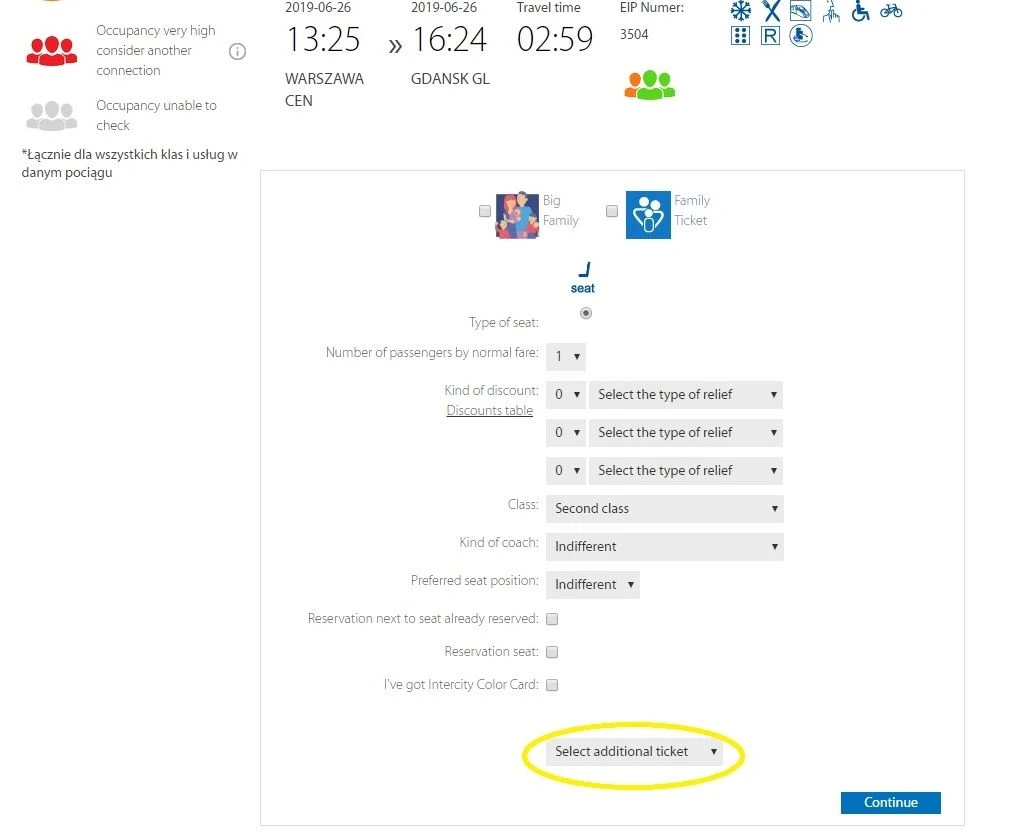
You can only purchase 2nd class tickets if you travel with a bike on the EIC and EIP trains, the dedicated bike storage areas are in the part of the train which has 2nd class seats – the booking system should allocate you a seat reservation in the coach in which the bike storage is located.
The trains used for the IC and TLK services tend not to have dedicated bike storage, so you should board by the first or last doors on a train and stow your bike by these doors, though the conductor will guide you as to what you need to do.
If you already have a travel ticket and will be taking a bike on board an EIC, IC or TLK service, you can opt to purchase a ticket from the train conductor.
Though you must notify the conductor immediately before or after boarding, but buying a bike ticket from the conductor costs an additional PLN 10.
For journeys by the EIP trains, if you haven’t booked a bike ticket online with your travel ticket, you must make an advance purchase at a ticket counter.
On the local and regional trains
On the regional and local trains operated by Polregio, bikes can either be stored in bike racks or luggage areas, which are marked by signage on the exterior of the trains.
If no storage space is available, you can board into the first and last doors of the train.
Polregio sells two types of flat rate bike tickets, the more expensive of which prioritises that space will be available.
So it’s worth checking at the station whether dedicated bike storage will be available on the train you want to take - and if it is you can de-stress a journey by paying slightly more for this ticket.
The other type of ticket costs PLN 7.
Portugal
Non-folding bicycles can be taken on all trains except the AP services and tickets are not required.
On the IC trains, up to two bike spaces are available in 2nd class coaches and the bikes must be placed in these - there are symbols by the doors which are adjacent to the bike spaces.
However, spaces cannot be reserved in advance - so if they're in use you may be denied boarding by the conductor.
Also you may need to find a space for your bike in a different coach to that in which your reserved seats will be located.
On the regional (R and IR) trains you can bring non-folding bikes on board and place them in non-dedicated areas. as long as you don't block the access to the train by other passengers.
So the conductor may be prevent bikes being taken on board if the train is exceptionally busy.
On the Urban trains, you can, in theory, board into any train.
Spain:
Non-folding bikes can only be taken on board any of the express train services - Altaria; Alvia; Avant; AVE; Euromed and Talgo if they are disassembled and placed in a bag or case measuring no more than 120 x 90 x 40cm (length-height-width).
If you can fit a bike in the case or bag, then you don’t have to buy a bike ticket; for an express train or any other journey, it in effect becomes a piece of hand luggage.
If you don’t want to disassemble a non-folding bike, you can only take it on the regional/local ‘Media Distancia’ services, including those that are specifically branded MD or Regional-Express, and the local trains in cities – including the Cercanias and FEVE trains.
If you will be travelling for less than 100km, you apparently don’t need a ticket, but for longer journeys there is flat rate bike transport fee of €3, which can be booked at station, or online on the Renfe website.
Adding the bike to an online booking will typically also ensure your bike will have a reserved place on the train.
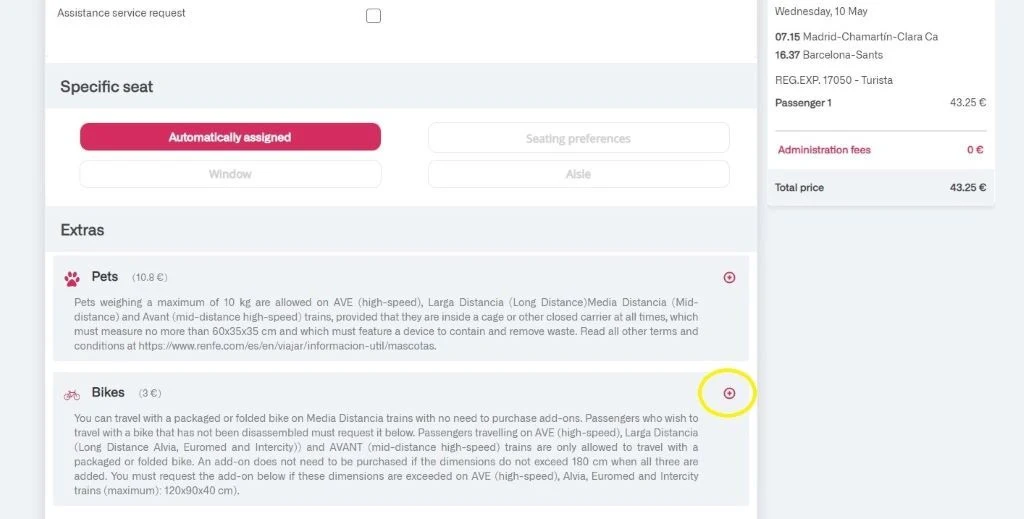
If you purchase a bike ticket at a major station allow plenty of time for this, as the process is what's used for oversized items of luggage, hence a procedure that's a lot more complicated than purchasing a typical train ticket; which is why it's now better to add the bike when booking online.
Some of these trains won’t have dedicated bike storage and on those that don’t, you can take a bike on board and be guided by the conductor as to where you should leave it – BUT there’s a slight possibility that the conductor will decide that there’s no room for a bike.
If bike storage is a provided for on the train you will be taking, you have to store a bike in these dedicated spaces, but by booking online you can be sure that space will be available.
Sweden:
SJ is the national rail operator in Sweden and it doesn’t permit non-folding bikes to be taken on board any of its trains - and they are also not permitted on the MTR Express trains, which compete with SJ Trains on the route between Stockholm and Goteborg.
Though bikes can be taken on board the Oresundstag trains, both for journeys between Sweden and Denmark and for journeys solely within Sweden;
These trains travel between Malmo/Lund and Goteborg, Karlskrona and Kalmar - more info is available here.
Bagged bikes can also be taking on the Vy Nattåg trains on the Stockholm - Boden - Kiruna - Narvik route.
Switzerland:
The vast majority of trains operated by the national rail operator SBB and the other key mainline operator BLS, are fitted with bike storage spaces, which are indicated on the outsides of the train.
Though some Swiss trains can be up to 12 coaches long, so being at the station early to work out where to wait for easy boarding is recommended.
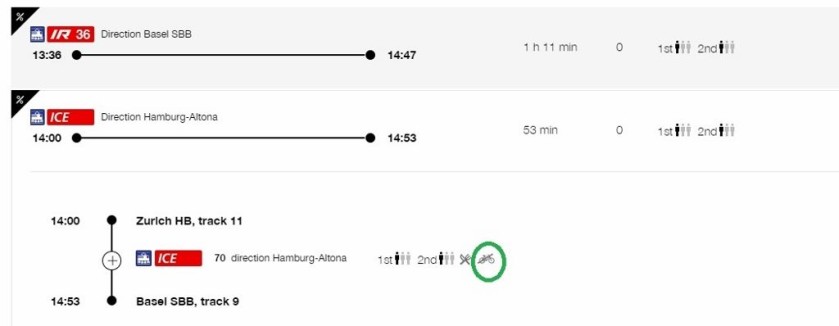
You can confirm whether a bike space will be available by looking up a journey on the SBB website, though what's unusual about SBB is that it tells you when a bike can't be taken on board, instead of whether bikes are permitted.
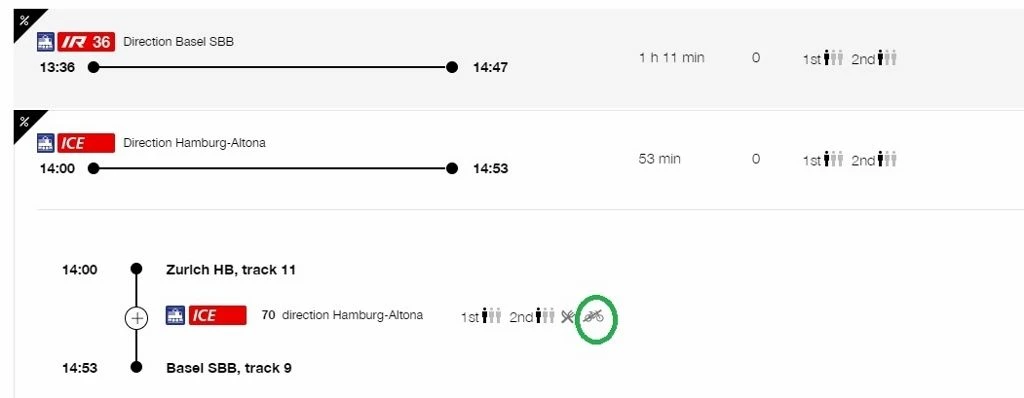
If you click on the black line between the departure and arrival times, you can access additional train info - note that the bicycle is crossed out, meaning that bikes are not permitted on this departure.
But this is the only bike symbol that SBB uses, so if you don't see it, you can take a bike(s) on board.
The primary service on which cannot be taken on board are the TGV trains between Basel and Zurich, but numerous other trains operate on this route.
On the SBB trains a day bike pass costs CH 14 and they can be booked online [here]https://www.sbb.ch/en/timetable/travel-advice/bicycles/take-your-bike-with-you.html). The only other bike ticket available is a short-distance Point-to-Point ticket, which costs half the Adult fare.
However, having a pass or ticket is no absolute guarantee that bike spaces will be available on the train you want to travel by - though virtually every railway route in Switzerland has a minimum of an hourly service, with departures every 30 mins being particularly common.
Taking the express trains
A bike reservation is also required which costs CH-5, when travelling on these services:
- Zurich - Zug - Arth Goldau - Bellinzona – Lugano (route IC 2) - daily
- Zurich - Zug - Arth Goldau - Bellinzona – Lugano (route IC 2) - daily
- St Gallen - Winterthur - Zurich Flughafen - Zurich HB - Olten - Biel/Bienne - Neuchatel - Lausanne (route IC 5) - daily
- Zurich HB - Olten - Biel/Bienne - Neuchatel - Geneve - Geneve Aeroport (route IC 5) - daily
- All other IC routes from Friday to Sunday and on summer holiday Mondays
- on any international express train for a journey within Switzerland.
On the independent railways
Many of the trains used by the independent railway operators also have dedicated bike spaces, though specific info about taking a bike on these trains is rarely available online, so it’s best to contact the railway you want to travel by, so that you can confirm what your options are and whether you need to pay for reservations or tickets.
Click on the links below to access the respective contact pages of the main independent companies
AB l BOB/JB/WAB
MGB l MOB
TMR l ZB
Though one company which definitely permits bikes on board all its regular trains is the Rhaetian Railway – its sells a day pass for bikes that costs CHF-20 and enables the ticket holder to explore any of its wonderful routes.
The Netherlands:
NS is the national railway operator in The Netherlands and it doesn’t allow bicycles to travel on any of its trains between 06:30 – 09:00 and 16:00 – 18:30 on Monday-Friday – except during July and August when there are no time restrictions.
Bikes can be taken on board any train at any other time, including weekends, if you purchase a bike pass for €6.90 - this pass known as a ‘Fietskaart Dal’ or 'Bicycle Card Dal' has a flat rate price, so it doesn’t matter how far you will be travelling.
But there are exceptions, in particular on Mon-Friday you cannot take non-folding bikes on any train between 06:30 - 09:00 and between 16:00 - 18:30.
Bike spaces can now be booked in advance of travel.
An unusual feature of travelling with a bike on NS trains is that tandems can also be taken on board.
Bikes can only be placed in the dedicated bike spaces and if you don't book them in advance, there’s no guarantee that room will be available.
Although neither your train ticket, or bike pass, will be restricted to specific departures, so if need be you can simply take the next train – most routes have departures at least every 30 mins.
Bikes cannot be taken on board on ICE or Thalys trains for journeys within The Netherlands.
International trains:
Standard non-folding bikes, which haven't been disassembled, cannot be taken on these European international daytime train services.
- the DB-SNCF high speed services between Paris and central Germany (TGVs and ICEs)
- the RENFE-SNCF high speed services between France and Spain (AVE trains and TGVs)
- the Snabbtag trains between Sweden and both Denmark and Norway
- the TGV France-Italy services
- the Thalys services
Though if you disassemble a bike by removing either the front or both wheels (and the handle-bars if need be), you can take it on board if the bag/case you place it in meets these size requirements:
- the AVE trains France <> Spain - 120 x 90 x 40cm (length-height-width)
- the TGV Lyria trains, (maximum size 120cm x 90cm)
- TGV trains between France and Belgium; Germany; Luxembourg; Italy and Spain - 120 x 90cm
- the Thalys trains - 135 x 85 x 30cm.
Seat 61 has a highly useful guide on how to travel with bikes on trains between the UK and multiple European countries.
EuroCity Trains
These EuroCity (EC) services are the standard international, non high-speed, European express train services and they operate on these routes.
All of the different types of trains used on these EC services and routes have dedicated bike storage spaces, or space in luggage vans, which have to be paid reserved and paid for prior to boarding
However, ShowMeTheJourney's understanding is that these bike tickets and reservations for the EC trains can't be booked online. The online bike ticket options, that are included in the details by country above, are only ever available for domestic journeys within those countries.
So usually the only option is to book these reservations at a station, if the station has an international travel desk it's best to use that, instead of an ordinary ticket counter.
Ideally do this when you first arrive in the location that you will be travelling from, leave it until just before boarding and it's less likely that space will be available.
Though if you will be taking an EC train services from Germany, you can order an international bike ticket by calling 01806996633 - these international bike tickets cost €10.
Eurostar
Eurostar has resumed the transportation of non-folding bicycles, but for the time being only on the London <> Paris route.
A flat rate of £30 per journey is charged for storing non-folding bikes on board a Eurostar train, but this fee can't be paid on the website when booking your journey tickets.
So it's best to call Eurostar's telephone booking service on 03448225822 from within the UK, or 044344822582 from outside the UK as soon as possible, bookings generally open around 180 days of the travel date - and then book the travel ticket and bike reservations over the phone as a single booking.
As explained on Seat 61, you can save money by disassembling a bike and placing it in a bag or box - and if you do that you can also increase the possibility of the bike(s) being accepted on to your first choice of Eurostar departure, spaces are more limited for assembled bikes.
Also worth knowing if you will be taking a non-folding bike, no matter how you prepare it for transport, is that only the trains between London and Lille, Paris and Bruxelles will accept a limited number of bikes on ANY departure.
Bikes cannot be transported on the last train of the day to Amsterdam and can't be conveyed at all to/from Ashford, Rotterdam, Ebbsfleet, or any of the destinations less regularly served such as Avignon, Lyon, Marne La Vallée, Marseille and the ski resorts served by Eurostar.
InterCity Bruxelles Trains
If you don't want to dis-assemble your bike, these IC Bruxelles trains are an alternative to taking a Thalys train in either direction between Belgium and The Netherlands.
Bike tickets for these IC trains cost €12, but can only be booked at stations in Belgium or The Netherlands.
ICE trains
Bike racks for non-folding bikes have been fitted to the new ICE Neo trains, which are now being used on many (but not quite all) departures on the routes between Germany and both Amsterdam and Bruxelles.
Bike racks for non-folding bikes have also been fitted to [the ICE 4 trains]/travel-on/train/119-ice-4-germany/) which are used on most services between Germany and destinations in Switzerland beyond Basel. - and on some departures to and from Wien / Vienna.
However, non-folding bikes cannot be taken on other ICE trains
Oresundtag trains
Non-folding bikes can't be taken on the Snabbtag trains between Denmark and Sweden, but they can be taken on these regional trains if you buy tickets in advance.
Tickets aren't sold online, but they can be purchased from the machines and booking counters at stations, they cost the same rate per journey as child tickets.
Railjets
Non-folding bikes can be taken on both Austrian and Czech Railjet trains for international journeys, reservations are required, but they're not available online when taking a cross-border trip.
So it's best to book at the station when you first arrive in a location, as a limited number of spaces will be available per departure.
(Night trains);
More info on this is promised for the future, as despite all of the above, SMTJ still has work to do - how take a bike on trains in Britain is also the list.
Though one thing we came across when looking up all the daytime train content, is that non-folding bikes can be taken on board the Nightjet on some routes:
Vienna ↔ Bregenz (6 bicycle parking spaces)
Vienna ↔ Hamburg (6 bicycle parking spaces)
Innsbruck ↔ Hamburg (6 bicycle parking spaces)
Graz ↔ Zürich (3 bicycle parking spaces)
Zürich ↔ Hamburg (3 bicycle parking spaces)
Vienna ↔ Zurich (3 bicycle parking spaces)
Zurich ↔Berlin (3 bicycle parking spaces)
Zurich ↔ Amsterdam (13 bicycle spaces bookable in IC 60402 / IC 60403)
Note that on the Zurich ↔ Amsterdam route, the bicycle spaces are in the IC train which is attached to the Nightjet train - and the IC train only conveys seated accommodation.
Please support ShowMeTheJourney
This second version of ShowMeTheJourney is exciting and new, so we are genuinely thrilled that you are here and reading this, but we also need your help.
We’re striving not to let anything get in the way of providing the most useful service possible, hence a facility has been set up with DonorBox which can be used to support the running costs and make improvements.
Instead of advertising or paywalls, your financial support will make a positive difference to delivering an enhanced service, as there’s a lot of ideas which we want to make happen.
So if you have found the info provided here to be useful, please go here to say thank you.

Simon Harper
I wanted to share my passion for train travel and explain how anyone can take the fantastic journeys I have taken.

This is one of more than 100 train travel guides available on ShowMeTheJourney, which will make it easier to take the train journeys you want or need to make. As always, all images were captured on trips taken by ShowMeTheJourney.
This second version of ShowMeTheJourney is exciting and new, so we are genuinely thrilled that you are here and reading this, but we also need your help.
We’re striving not to let anything get in the way of providing the most useful service possible, hence a facility has been set up with DonorBox which can be used to support the running costs and make improvements.
Instead of advertising or paywalls, your financial support will make a positive difference to delivering an enhanced service, as there’s a lot of ideas which we want to make happen.
So if you have found the info provided here to be useful, please consider saying thank you.

